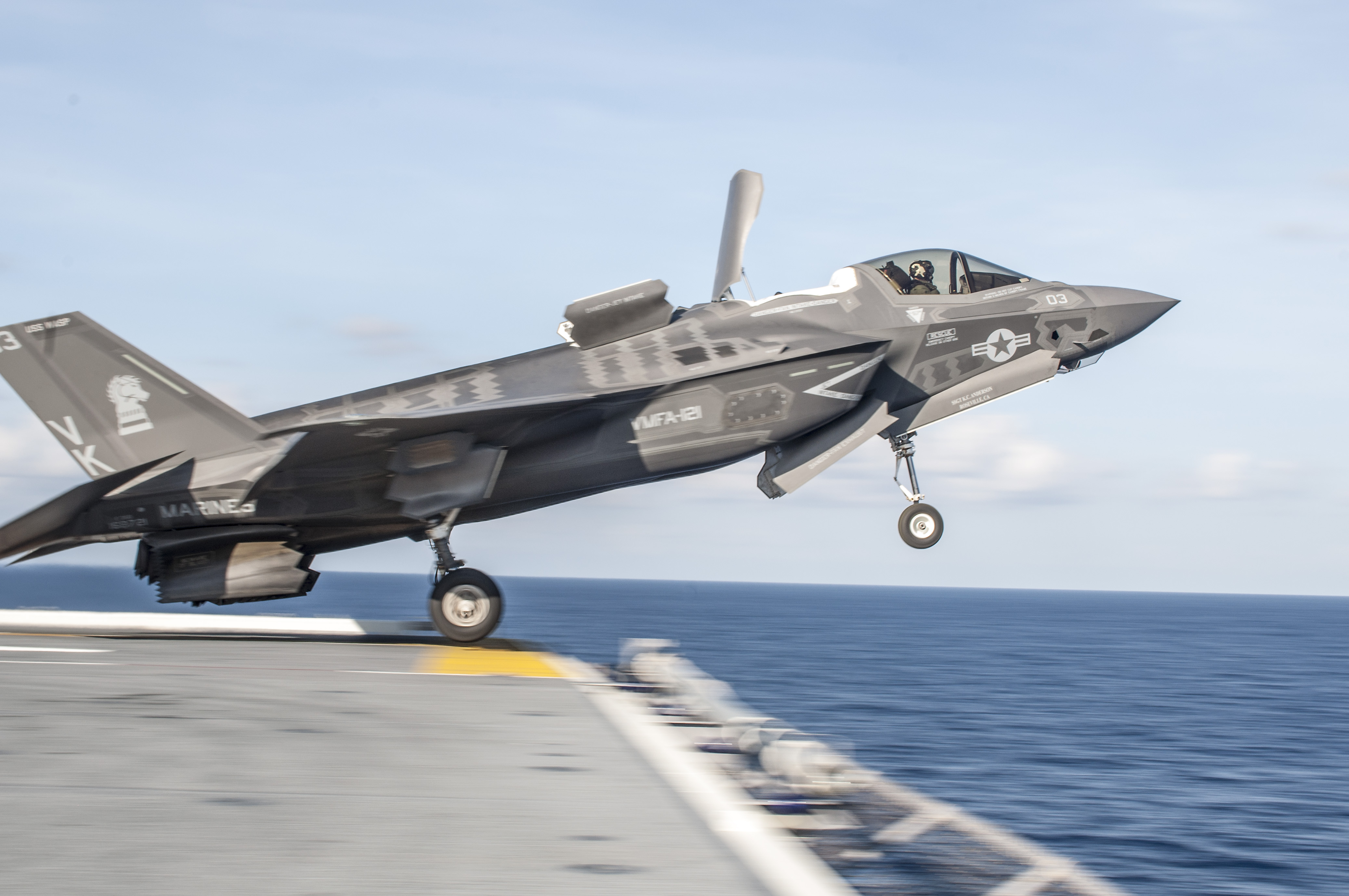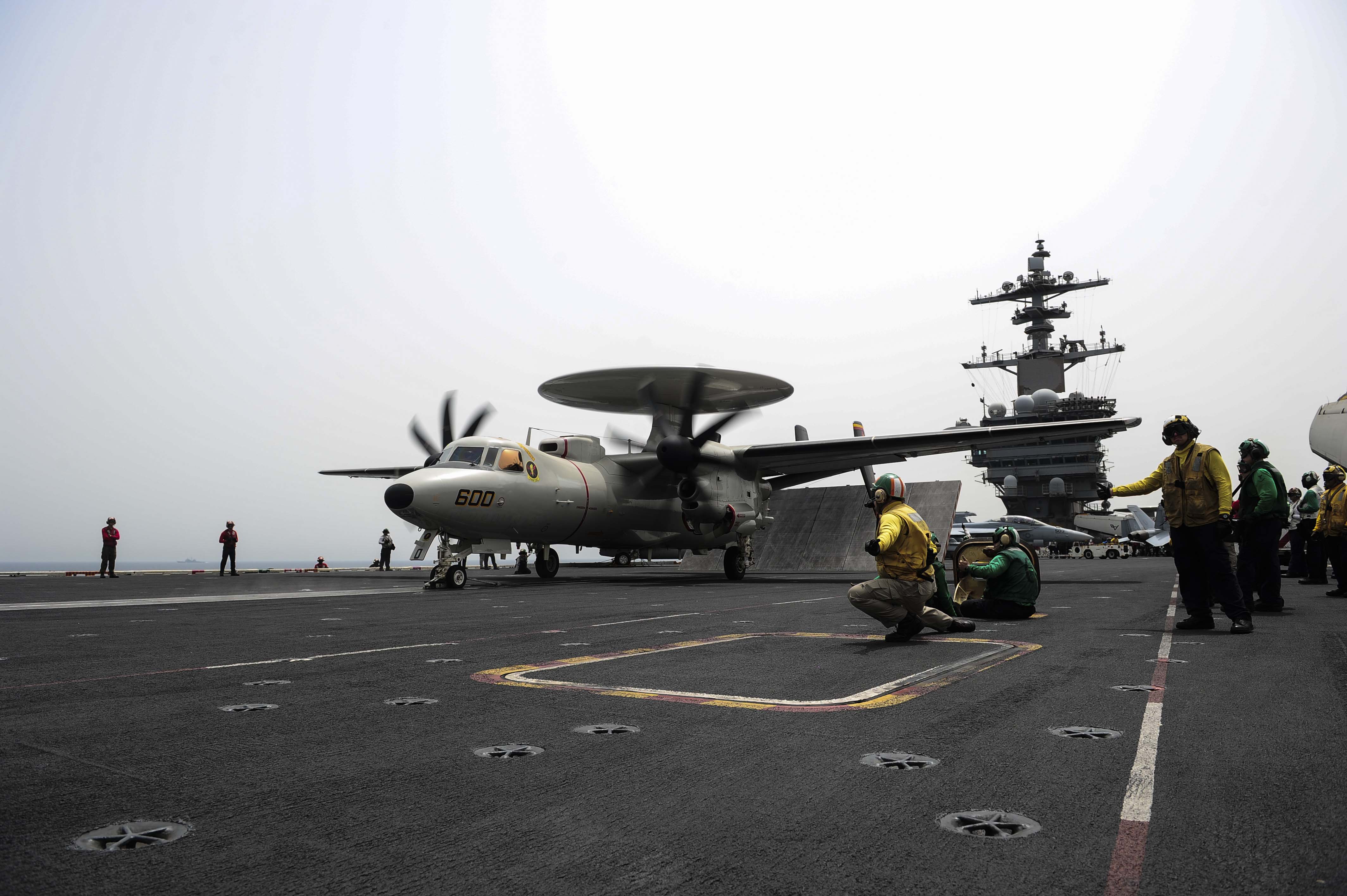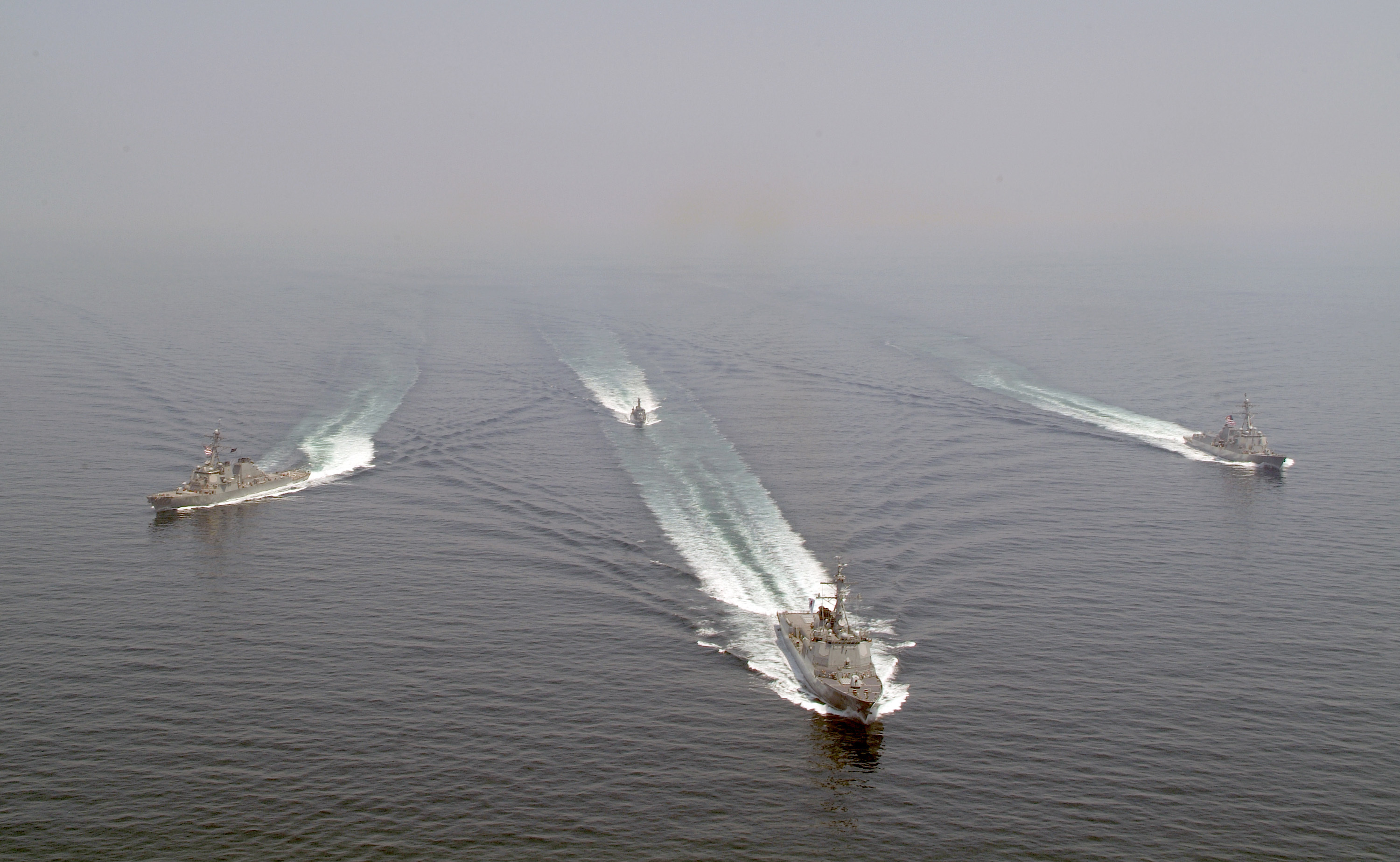
The U.S. Navy’s Aegis Weapon System revolutionized fleet air defense at the height of the Cold War. The 1983 commissioning of the first Aegis guided missile cruiser USS Ticonderoga (CG-47) and the 26 cruisers that followed provided the Navy with unrivaled capability at a time when an expansionist Soviet navy was bent on challenging the United States on the world’s oceans.
Armed with a variety of anti-ship cruise missiles launched from aircraft, surface ships, and submarines, the Soviet fleet focused on destroying aircraft carriers—the “crown jewels” of the U.S. Navy. In response, Aegis was the “shield of the fleet,” capable of detecting, tracking, and sorting through hundreds of contacts and engaging numerous targets simultaneously out to unprecedented ranges. Without doubt, Aegis ushered in a Navy-wide revolution at sea.
In mid-2016, 33 years since the Ticonderoga joined the fleet, the Navy has 86 Aegis cruisers and Arleigh Burke-class (DDG-51) destroyers in service. Aegis shields the fleet at sea and also forces and installations ashore against hostile aircraft and cruise missiles. Further, the Aegis defensive envelope has expanded exponentially to defeat ballistic missiles. Importantly, concepts like Integrated Air and Missile Defense (IAMD) and Naval Integrated Fire Control-Counter Air (NIFC-CA) are poised to re-revolutionize capabilities of the nation’s Aegis warships.
And this has implications for the Navy’s Distributed Lethality Task Force as it looks to expand offensive sea control capabilities and operations to hold our adversaries’ naval forces at risk – particularly the resurgent Russian and rising Chinese navies.
The most recent Aegis upgrade is Baseline 9 with the IAMD capability that enables a single surface warship to conduct ballistic missile defense and anti-air warfare simultaneously. Baseline 9 also connects the NIFC-CA architecture that is now at sea in growing numbers of surface warships. NIFC-CA uses Aegis radar, an airborne sensor – the E-2D Advanced Hawkeye airborne early warning (AEW) aircraft – and surface-to-air Standard missiles to detect, track, and engage airborne threats well beyond the horizon. Instead of working with traditional, two-dimensional, linear “kill chains,” naval strategist Norman Polmar explained that Aegis/IAMD/NIFC-CA “kill-webs” will permit various naval platforms to have access to sensors and targeting data – using highly advanced on-board, external, naval, and national sensors – rapidly and through secure links. It is the essence of distributed lethality.
A key component of the “kill web” in the near term is the SM-6 surface-to-air missile, which is now entering service. “We are going to create a brand-new capability,” according to Secretary of Defense Ashton Carter. “We’re modifying the SM-6 so that, in addition to missile defense, it can also target enemy ships at sea at very long ranges.” Using both active and semi-active guidance, enabling offensive attacks that can discriminate between adversary and friendly/neutral targets, the Navy successfully tested the surface-to-surface-mode SM-6 in January 2016. And, the service is now introducing the SM-6 anti-ship modification into Baseline 9 Aegis warships.
The E-2D Advanced Hawkeye AEW aircraft link in the IAMD/NIFC-CA “kill web” is inextricably tied to the Navy’s nuclear-powered aircraft carriers (CVNs). These carriers deploy with four or five E-2 Hawkeyes, fourth-generation F/A-18 Hornet/Super Hornet fighter-attack aircraft, and helicopters. This has spawned proposals that Marine Corps fifth-generation F-35B Lightning II Joint Strike Fighter (JSF) complement the CVN/E-2D Advanced Hawkeye in the Aegis/IAMD/NIFC-CA “kill web.”
Much like Tico’s debut in 1983, when the Marine’ F-35B JSF reached initial operational capability in July 2015 it marked yet another revolution at sea.
“A flying computer and sensor network that displays everything to the pilot on a helmet,”
Deputy Secretary of Defense Robert Work remarked. “I don’t consider it a fighter plane. I consider it a flying component of an air combat network. And the reason why we believe it is going to be so effective is because of the way it sucks in all the data and presents it to the pilot.”
The F-35B is a short takeoff/vertical landing (STOVL), supersonic, stealthy multi-role aircraft that will operate from the Navy’s nine large-deck amphibious assault ships (LHAs and LHDs) and from austere facilities ashore.
Using the F-35 as an airborne relay node or sensor to complement the E-2D Advanced Hawkeyes seems to be a winning proposition. What Deputy Secretary Work called “a flying component of an air combat network,” F-35 sensors include the Active Electronically Scanned Array (AESA) radar capable of air-to-air operations, air-to-surface operations, and a broad spectrum of highly classified electronic warfare and intelligence, surveillance and reconnaissance missions. The Distributed Aperture System (DAS) is a sensitive and discriminating array of six sensors that gives the pilot data not just from in front of the aircraft, but directly below, above and to the sides: 360-degree situational awareness. The aircraft’s Electro-Optical Targeting System (EOTS) carries out air-to-air and air-to-ground infrared searching, tracking and targeting.

That said, one of the key challenges the Navy/Marine Corps team will have with F-35Bs on LHA/Ds compared to operating JSFs off a carrier is the lack of an E-2D to adequately connect the command element afloat and the aircraft in real time. The F-35B can complement the E-2D by providing target cueing data so that the E-2D can use its own sensor to locate and ID the target and generate a target-quality track; however, the F-35B without the Advanced Hawkeye does not have the command and control capability (like the E-2D or Aegis combat system) or the manpower to sufficiently ID targets and command and control multiple engagements. For example, while fitted with Link 16, the F-35B does not have Cooperative Engagement Capability, and there is no plan for the aircraft to get the CEC “box.”
Still, the increasing capabilities of the Aegis system – including advanced missile-defense weapons—coupled with F-35B aircraft operating from amphibious ships and the F-35C Navy variant JSF embarked on CVNs contribute to the evolving Distributed Lethality (DL) concept. DL will provide the U.S. Navy with needed offensive sea-control effectiveness to counter the “rising” Chinese and “resurgent” Russian threats to U.S. and allied naval forces. Indeed, “blending” Aegis with F-35B/C would result in the DL whole being significantly more than the sum of its individual parts.
The DL concept calls for a new approach for how the nation might use its naval air, surface and submarine forces as potential adversaries acquire advanced capabilities to control the sea in crisis and conflict. Expanding the offensive lethality of surface forces – which can be geographically distributed throughout maritime operating areas – will add another dimension to U.S. warfighting capability. And, shifting naval surface forces to the offensive to conduct lethal expanded sea-control operations will directly contribute to carrier/expeditionary strike group mission success.
“Distributing the lethality of the force allows you not only to continue to win today, but well into the future,” according to Vice Adm. Thomas Rowden, Commander of Naval Surface Forces. “It ensures that our adversaries and potential adversaries understand that we have a Navy that can execute sea control well. To be able to do that and do it effectively,” he explained in the U.S. Naval Institute Proceedings, “you have to be able to execute not only the defensive operations but also significant offensive operations. That’s really where we are going.”
Upgraded Aegis, advanced weapons, IAMD and NIFC-CA and the F-35 look to alter the strategic calculus for both offensive and defensive warfighting, thus meeting Vice Adm. Rowden’s intentions.
Marine Corps Commandant Gen. Robert Neller in February 2016 said that he wants to see amphibious forces participate in missions outside of traditional amphibious operations. The introduction of the F-35B brings a fifth-generation capability to the Marines several years before the Navy’s F-35C carrier variant reaches the Fleet. He said that previously, in a crisis, people would look to the aircraft carrier to respond. Now “with all due respect to the carrier strike group,” he suggested, “the next question’s going to be, where are the F-35s…. where are those Marine jets?”
The Director of Expeditionary Warfare (N95) in the Office of the Chief of Naval Operations, Maj. Gen. Christopher Owens, emphasized the requirement to develop new concepts of employment that exploit the unique capabilities of both the JSF-enhanced amphibious ships and the carrier strike group. “As you look at having fifth-generation fighters aboard amphibious big decks before we have them aboard CVNs, we need to look at how we integrate the F-35Bs into the larger naval campaign – how to exploit what that aircraft provides without having the equivalent of an E-2 on the amphib. For instance, how can we pair up the amphibious big decks with the carrier strike groups to provide that fifth-generation capability to the larger fleet and integrate with the fourth-generation capability that is resident on the CVNs?”
“You can never replace the capability that a carrier strike group delivers,” Vice Adm. Rowden underscored to the Proceedings. “But I do think it’s important to understand what other tools may exist in the form of AFPs [Adaptive Force Packages]. … Imagine an AFP centered around an ARG [Amphibious Ready Group]. With the ARG’s current capabilities – including what’s flying off the decks of the ships, the Marines on board, and also the combat systems that are significant in our [San Antonio-class] LPD-17s and our large-deck amphibs – we also have to think ahead as we start to bring the F-35B into the force and understand what contributions it might bring to an adaptive force package that could perhaps be augmented by some of our guided-missile destroyers.”

That transformation has already begun. In April 2016, a three-destroyer surface action group (SAG) – USS Decatur (DDG 73), Momsen (DDG 92) and Spruance (DDG 111) – deployed to U.S. 7th Fleet area of responsibility to test the DL concept. In late 2017, the F-35B will first deploy with the first expeditionary SAG comprising a big-deck amphib and a handful of cruiser or destroyer “shooters,” according to Adm. Scott Swift, U.S. Pacific Fleet commander.
“I think this is going to revolutionize where we are with expeditionary strike groups,” Adm. Swift noted. “The [2016] three-ship PAC SAG…will pave the way for another SAG, just like this one, attached to the large-deck amphib so that it will become what I’m calling an ‘Up-Gunned ESG’.”
There’s an international dimension to the Aegis/JSF “blend.” In addition to the U.S. Navy, five world navies operate or are acquiring Aegis warships:
- Australia is building three Hobart-class destroyers
- Japanese Maritime Self-Defense Force has four Kongo and two Atago DDGs
- Republic of Korea navy operates three Sejong the Great DDGs and has reviewed acquiring another three while pursuing as many as six KDX-IIA DDGs
- Royal Norwegian Navy operates five Fridtjof Nansen frigates
- Spain has five F-100 Alvaro de Bazan frigates
According to Lockheed Martin, “Joint coalitions with fleets of fully interoperable F-35s will have the capacity to operate with unimpeded collaboration, while maintaining security and air superiority.” The planned quantities of all three variants are as follows:
- Australia, 100
- Canada, 65
- Denmark, 30
- Israel, 33
- Italy, 90
- Japan, 42
- Netherlands, 37
- Norway, 52
- South Korea 40
- Turkey, 100
- United Kingdom, 138
- United States, 2,443
As Dr. Robbin F. Laird explained, “Aegis and the Joint Strike Fighter, as well as the interaction between them, demonstrate how the United States is using military technology to strengthen America’s worldwide network of alliances. To begin with,” he continued, “the programs are designed to strengthen the economic interdependence of America’s allies across the globe, with each nation embracing comparative advantages in producing various parts for the Aegis and JSF, as well as further innovating them. At the same time, systems like the F-35 and Aegis inherently foster greater interoperability between the militaries that use them.”
This insight will be important as DL wargames and experimentation include allies and maritime partners to help flesh out concepts of operations and tactics.
For example, an AFP/SAG/ESG comprising a large-deck LHA/LHD embarking F-35B strike-fighters, Aegis guided missile cruisers or destroyers, and perhaps an LPD-17 amphibious transport dock ship operating within the Aegis/IAMD/NIFC-CA/JFS “kill web” offers potentially game-changing results––complementing what the carriers bring to the equation.
To paraphrase a “bottom-line bumper-sticker” popular during the early years of the Aegis shipbuilding program: Aegis and the F-35B––don’t leave homeports without them.




